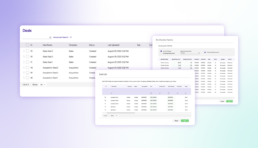While the creation of intellectual property is the inciting incident that kicks off our journey on the IP commerce highway, the IP deal is the navigation system that sets the course for the property’s legal and financial trajectory. Like the negotiation process itself, the work of capturing constantly-evolving deal data is a complex and collaborative process that requires a reliable, flexible solution to provide actionable insights to all relevant team members. Let’s cruise through a deal creation experience and note some of the roadblocks we need to circumnavigate.
Let’s Make a Deal Memo

For IP opportunity data to be accurate and effective, the system of record must capture every contractual term and detailed rights variation. At the same time, any team member should be able to see at a glance the high-level summary of the deal’s intent, without diving deep into minutiae. This deal memo structure should allow for swift, standardized entry of data such as:
- Parties involved
- Properties in scope
- Contract term start and end dates
- Total financial amount
External parties are key for understanding the context of the deal, to indicate who is the licensee vs. the licensor, and to track other co-owners or co-producers for whom the deal will have contractual and financial implications. Meanwhile, the assignment to internal parties such as a company division often drives other business logic, such as establishing reporting currencies and exchange rate preferences for the deal, and formalizing who takes responsibility for each part of the deal’s lifecycle.
The IP itself is a critical component of deal data, and a robust solution needs to understand when newly generated “catalog” records fall into the existing scope of a deal and therefore should automatically be added to all relevant Rights to keep everything dynamically aligned. For example, a Brand or Season is part of the initial deal, and when new child elements or episodes are subsequently created, they automatically and clearly display as part of the rights-relevant hierarchy on that deal. There are also exception cases such as output deals where the exact properties are intentionally not determined at the outset to the agreement, which means it needs to be easy to add a high volume of catalog items to the deal and rights at a later stage.
Rights and Conflicts
Beyond the high-level deal summary, more granular rights need to be captured in a standard format to feed availability calculations and other reporting needs. A single contract often specifies differing rights per property, further exploded by rights dimensions such as territory, language, and type of use. Without purposefully designed solutions to expedite and standardize the creation of this rights data, teams often struggle to understand what they are able to do with any given property.
“Exclusivity” is a fundamental ingredient in IP rights monetization, so a rights management solution must alert users when rights on a new deal are impermissible for a particular property based on pre-existing rights data. This legal conflict can occur for a number of reasons:
- Underlying “rights in” have never been recorded for the proposed sale terms against that property
- A child record lacks some rights in, or has a specific restriction that effectively limits the sale of the parent (e.g., one television episode lacks a Clearance in a territory for sampled music, and therefore the parent season/series is blocked from sale in that region until the Clearance has been secured)
- Overlapping exclusive sales rights are also tied to a separate deal that was either preexisting or drafted concurrently with the in-progress deal
And while all of these scenarios are legally blocking reasons to pause a deal’s progression, in practice it is often necessary for authorized users to override these alerts temporarily, accompanied by an auditable explanation of why that person believes the conflict will be resolved and should no longer block that deal’s progress.
Financial Terms
Any IP rights system is expected to track and validate legal implications of each deal at a bare minimum; but the financial obligations are at least equally important to capture and make actionable. To facilitate easy reference and reporting, monetary values need to be summed up at the top level of the deal, often in the form of a “deal total” calculated from the sum of all of the deal’s payment schedule installments or minimum guarantee entries. When more than one property or a hierarchy of titles is in the scope of the deal, that overall deal total also commonly needs to be broken down into allocations per title, and even further exploded by models for dimensions. For a video-on-demand example, each per-Episode allocation would be split up into granular entries for each combination of Territory and Media bucket:
- 70% for the Americas, 20% for EMEA, 10% for APAC
- Further split out to 55% for SVOD and 45% for AVOD
Sub-allocations output by those models in turn feed accounting processes such as revenue recognition and cash application, ultimately resulting in the generation of detailed journal entries that need to be traceable back to the originating deal, property, and combination of rights dimensions.
In the case of an acquisition, where Rights In are tracked against properties on a deal, the per property, per rights dimension Allocations should be broken out into monthly portions to Amortize that monetary value over time. These Amortization methods might fall into an equal straight-line distribution for every month of the Rights In windows captured on the deal, or might follow pre-configured business logic that assigns a higher portion during periods when the property’s value should peak and transition to lower values in the long tail periods at the end of the rights term.
Life of a Deal
An IP rights deal is a living record that changes frequently as it evolves into a finalized agreement status, and subsequently holds legal and financial implications for years into the future. To follow the dynamic and cross-departmental nature of a contract lifecycle, companies need customizable workflow processes, with appropriate permissions at every step and time-saving automations available along the way:
- Document generation to create a shareable contract file based on relevant data from the deal record
- E-Signature integrations to disseminate that contract, collect approvals in the appropriate order, and automatically progress the deal’s status
- Amendment Versioning to snapshot key points in the negotiation history, coupled with a complete audit trail of every change made to the deal, its rights, and any other associated records or parties
Throughout the entire life of a deal, communication is key both internally and externally.
When someone needs to bring attention to a specific deal, the rights management solution should be able to generate a notification that pulls in information from important fields and associations, and then sends that notification to specified parties from the deal. Even more importantly, the system should be capable of sending out date-based alerts without any manual intervention, for instance to start conversations about agreements that are approaching expiration.
The Right Tool for Rights Opportunities
At Rightsline, we understand the importance and the challenges of capturing deal and rights information effectively, and our perpetually enhanced software is formed from years of working directly with rights management professionals across industries to make their work easier. Knowing that specific and standardized rights data are critical to power actionable reporting, we continue to build complimentary rights entry features like bulk creation wizards, chained window profiles, and easy ways to filter, search, and bulk update rights across multiple deals or within the context of a single record. Like every other record type in Rightsline, deals are configured with fully flexible workflows that can generate contracts, integrate with e-signature flows, increment versions, control editability, and trigger custom logic via event-driven architecture.

Meanwhile, a rapidly developing suite of interconnected deal financial tools enables Rightsline users to automate allocations to the desired level of granularity, apply self-configured amortization models, and establish comprehensive logic to generate debit and credit journal entries based on operations such as revenue recognition and cash application. At Rightsline we recognize that every bit of information on a rights deal carries immense legal and financial significance, and we take it as our mission to empower IP commerce companies with accurate and actionable deal data.

